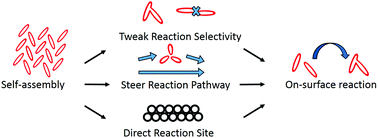The control of assembly structures that subsequently help achieve viable functionalities has been one of the key motivations for the exploration of surface molecular assembly. In terms of its functionality and applicability, the assembly is explored as a strategy to steer on-surface reactions primarily by two methods: assembly-assisted and assembly-involved reactions. The functions of the self-assembly strategy are threefold: tweaking reaction selectivities, steering reaction pathways, and directing reaction sites. The governing principle herein is that the assembly strategy can apply a surface confinement effect that affects the energy barrier and pre-exponential factor of the Arrhenius equation for the dynamics of the target reaction. Development of such a strategy may reveal new routes to steer on-surface reactions and even single molecule properties in surface chemistry.
